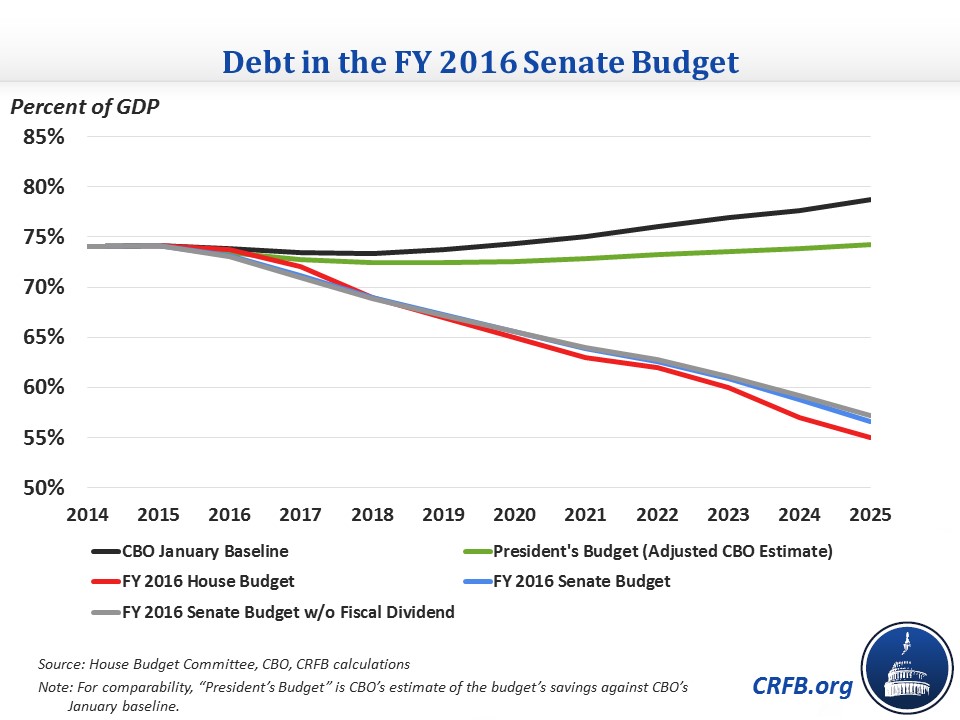Chairman Enzi Debuts FY 2016 Senate Budget
Senate Budget Committee Chairman Mike Enzi (R-WY) has released his FY 2016 budget resolution, which prescribes $5.1 trillion of spending cuts to reach a balanced budget by 2025. Those spending cuts, which exclude savings from drawing down war spending, include $4.2 trillion of program changes (almost entirely from mandatory spending including the Affordable Care Act), $710 billion of interest savings, and $164 billion from the "fiscal dividend" that counts the economic benefits (and short-term costs) of the deficit reduction contained in the budget. The Senate budget is slightly less aggressive than the House budget, with most of that difference coming from fewer non-defense discretionary cuts.
With its relatively aggressive savings targets, the Senate budget would put debt on a sharp downward path as a percent of GDP, from 74 percent in 2015 to 57 percent by 2025. Even excluding the fiscal dividend's effects on spending and revenue (the budget does not count the increased growth in its GDP numbers), debt would only be about 0.6 percentage points higher.

The budget also significantly reduces deficits, having them fall from 2.7 percent of GDP in 2015 to 0.5 percent in 2018 and to a small $3 billion surplus by 2025. Although the budget would not balance without the fiscal dividend, it would only record a small deficit of $52 billion (0.2 percent) in that year. Even then the budget might be close to balance, because the budget bases its numbers off CBO's January baseline, which has a $49 billion higher 2025 deficit than CBO's most recent baseline released last week.

Enzi's inaugural budget is very similar to the House budget. It relies mostly on mandatory savings and particularly savings in health care programs – getting $2.5 trillion from repealing the Affordable Care Act's coverage provisions and block granting and limiting the growth of Medicaid. The Senate budget also explicitly states that it saves an equal amount in Medicare as the President's budget – though it doesn't endorse the specific policies – which results in $250 billion more Medicare saving than the House budget. It also includes about $1.2 trillion of other mandatory savings that are largely unspecified and adheres to current law revenue levels.
Unlike the House budget, though, the Senate budget sticks to sequester levels for defense and reduces non-defense discretionary budget authority by $236 billion through 2025. By contrast, the House raised defense budget authority by $387 billion and compensated with non-defense cuts more than three times as large. It also sets FY 2016 war spending at the President's request of $58 billion and creates a 60-vote point of order against making that spending higher, rather than increasing it to $94 billion to accommodate additional defense spending as the House budget does.
| Policy Changes in the FY 2016 Senate Budget | |
| 2016-2025 Savings | |
| Affordable Care Act and Medicaid | ~$2,500 billion |
| Medicare | ~$430 billion |
| Other Mandatory | ~$1,200 billion |
| Social Security | $0 billion |
| Discretionary | $97 billion |
| Revenue | $0 billion |
| Interest | $710 billion |
| Subtotal, SBC Claimed Policy Savings | ~$4,940 billion |
| Fiscal Dividend | $164 billion |
| Subtotal, Claimed Savings with Fiscal Dividend | $5,100 billion |
| Baseline Adjustments | $970 billion |
| Total, Claimed Savings Compared to CBO January Baseline | $6,070 billion |
Source: Senate Budget Committee, CRFB calculations
We will continue to dive into the House and Senate budgets in the coming days and compare them with alternative budgets as they come out. You can also read more about developments with the FY 2016 budget here.


